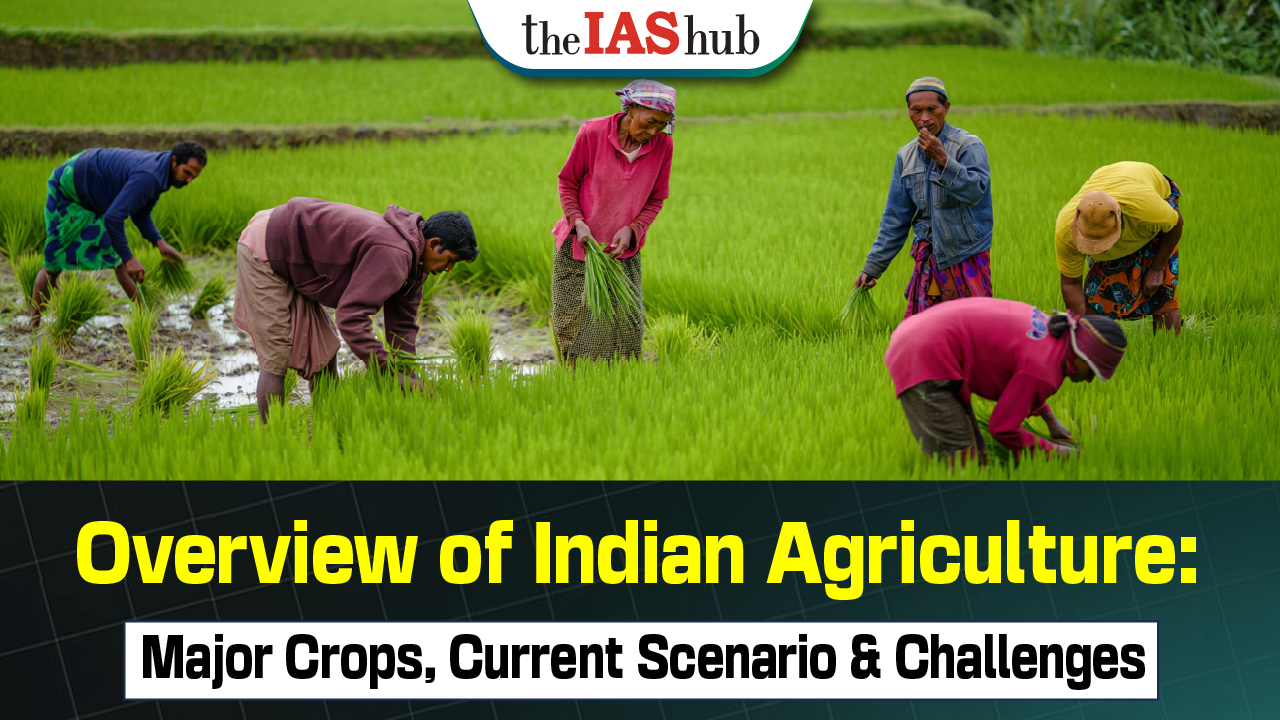India is a global agricultural leader with diverse cropping patterns and significant contributions to the economy. Explore its major crops, current agricultural scenario, and key challenges faced by farmers.


India is a global agricultural powerhouse. It is the world’s largest producer of milk, pulses, and spices, and has the world’s largest cattle herd (buffaloes), as well as the largest area under wheat, rice and cotton. It manages to handle 65% rainfed area effectively.
It is the second largest producer of rice, wheat, cotton, sugarcane, farmed fish, sheep & goat meat, fruit, vegetables and tea.
Current Scenario of Indian Agriculture
|
India is a country with an agrarian economy, with over 54% of the country’s land classified as arable and agriculture industry comprising half of labour market. India's climate varies from humid and dry tropical in the south to temperate alpine in the northern reaches. This diverse climate supports a variety of crops.

|
CROPS |
CHARACTERISTICS |
CLIMATE |
Issues |
|
RICE |
India 2nd largest producer in World. West Bengal is the largest producer in India. Other major producers are Uttar Pradesh and Punjab. |
It is Kharif crop which requires high temperature (above 25) and high humidity with annual rainfall above 100 cm |
Loss in the productivity due to repeated areas under the same crops. Depletion of nutrients from soils . |
|
WHEAT |
India is the 2nd largest Wheat producer. Important Wheat growing regions – Ganga – Satluj in North West and black soil region of Deccan Second most important cereal crop |
Rabi crop requires a cool growing season and 50-60cm rainfall |
Imbalance in the use of fertilizers especially nitrogen fertilizers. Low water use efficiency, problems of soil degradation. |
|
SUGARCANE |
Second largest producer after Brazil. Major producers are Maharashtra, Uttar Pradesh, Karnataka,Tamil Nadu |
It is tropical as well subtropical crop grows well hot and humid climate with temperature of 21-27 and annual rainfall between 75-100cm. |
Depletion of Ground Water resources, soil degradation |
|
Cotton |
India got 1st place in the world in cotton acreage with 120.69 Lakh Hectares area under cotton Cultivation. Gujarat is currently the leading producer of cotton in India followed by Maharashtra. |
It is tropical crop grows well in hot and humid climate with temp of 21-27? and annual rainfall between 75-100cm. |
Heavy use of pesticides, pest infestation, rising cost of seeds, farmer indebtedness-suicides. |
|
MAIZE |
Both used as food and fodder. Third most important food crops after rice and wheat. Andhra Pradesh (20.9 %), Karnataka and Rajasthan are major producers |
Kharif crop which requires temp between 21-27? and grows well in old alluvial soil. |
High input cost, pest infestation e.g. Fall Army Worm Poor weed management. |
|
MILLETS (coarse grains) |
India is the largest producer of millets in the world. Jowar, Bajra and Ragi are important millets. Major producers: Rajasthan, Karnataka, Maharashtra, Uttar Pradesh |
They are rainfed crops grown mostly in moist areas which hardly needs irrigation. |
Droughts and erratic rainfall Lack of irrigation facilities Attack of pest and diseases, low price realization by famers |
|
PULSES |
India is the largest producer, importer and consumer of pulses. Rajasthan, Madhya Pradesh, Maharashtra are the major producers. Arhar (Tur), Urad (Blackgram) and Moong (Greengram) are major produce of pulses in India. |
Grown both as kharif and rabi crop. Needs less moisture and survives even in dry condition. |
Lack of high yielding varieties of seeds, attack of pests and diseases, unfavorable prices |
|
OILSEEDS |
Major oil seeds are Mustard, soybean, sesamum. India is the 4th largest producer in the World. |
Almost 72% of the total oilseeds area is confined to rainfed farming cultivated mostly by marginal and small farmers. |
Soil acidity problem, particularly in North east, lack of mechanization of operations |


Refine your answer writing skills and elevate your UPSC preparation with personalized support and expert feedback.
Fill out the form to get started with the program or any other enquiries !








Are you dreaming of becoming an IAS officer? Then, IAShub can be your best guide. It is one of the Best IAS Coaching in Delhi. Many students who want to clear the UPSC exam join IAShub for learning. The institute gives both online and offline classes. Their teachers are experienced and helpful. They easily explain every topic. Students also get notes, tests, and tips to do well in the exam.
IAShub is in Delhi and is trusted by many UPSC students. It offers coaching for every part of the UPSC exam – Prelims, Mains, and Interview. The classes are simple and easy to understand. The teachers are experts and guide students in the right way. IAShub is also known for its helpful notes, test series, and answer-writing practice. IAShub is the best coaching in Delhi and also gives UPSC Online Classes. This helps students from any place in India to learn. The online classes are live and also recorded. So, students can watch them anytime. These classes cover the full UPSC syllabus.
Here are some important services provided by IAShub:
The UPSC Civil Services Exam has three parts:
This exam is tough, but with the right guidance, it becomes easy to manage. Students must study smart and stay regular.
IAShub supports students from the beginning to the end. It gives the right books, tests, and notes. The classes are easy to follow, and the teachers are always ready to help. Students get personal doubt sessions too. The test series and answer checking help students learn where they need to do better. Also, free study materials save time and money.
IAShub also guides students during the final stage – the interview. Experts take mock interviews and give useful tips. This full support makes IAShub one of the best IAS coaching in Delhi.